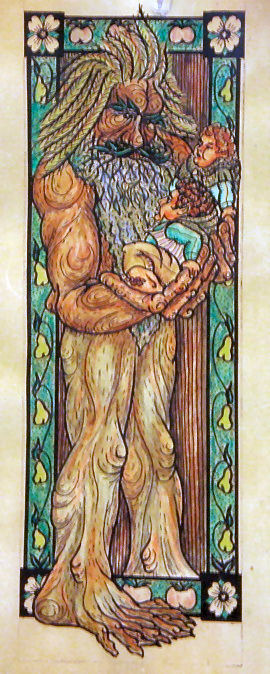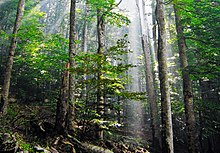Treebeard, or Fangorn in Sindarin, is a tree-giant character in J. R. R. Tolkien's The Lord of the Rings. He is an Ent and is said by Gandalf to be "the oldest living thing that still walks beneath the Sun upon this Middle-earth." He lives in the ancient Forest of Fangorn, to which he has given his name. It lies at the southern end of the Misty Mountains. He is described as being about 14 feet in height, and in appearance similar to a beech or an oak.

Rohan is a fictional kingdom of Men in J. R. R. Tolkien's fantasy setting of Middle-earth. Known for its horsemen, the Rohirrim, Rohan provides its ally Gondor with cavalry. Its territory is mainly grassland. The Rohirrim call their land the Mark or the Riddermark, names recalling that of the historical kingdom of Mercia, the region of Western England where Tolkien lived.

The Two Towers is the second volume of J. R. R. Tolkien's high fantasy novel The Lord of the Rings. It is preceded by The Fellowship of the Ring and followed by The Return of the King. The volume's title is ambiguous, as five towers are named in the narrative, and Tolkien himself gave conflicting identifications of the two towers. The narrative is interlaced, allowing Tolkien to build in suspense and surprise. The volume was largely welcomed by critics, who found it exciting and compelling, combining epic narrative with heroic romance.

The Battle of Helm's Deep, also called the Battle of the Hornburg, is a fictional battle in J. R. R. Tolkien's The Lord of the Rings that saw the total destruction of the forces of the Wizard Saruman by the army of Rohan, assisted by a forest of tree-like Huorns.
In J. R. R. Tolkien's fantasy writings, Isengard is a large fortress in Nan Curunír, the Wizard's Vale, in the western part of Middle-earth. In the fantasy world, the name of the fortress is described as a translation of Angrenost, a word in the elvish language Sindarin, which Tolkien invented.
"The Scouring of the Shire" is the penultimate chapter of J. R. R. Tolkien's fantasy The Lord of the Rings. The Fellowship hobbits, Frodo, Sam, Merry, and Pippin, return home to the Shire to find that it is under the brutal control of ruffians and their leader "Sharkey", revealed to be the Wizard Saruman. The ruffians have despoiled the Shire, cutting down trees and destroying old houses, as well as replacing the old mill with a larger one full of machinery which pollutes the air and the water. The hobbits rouse the Shire to rebellion, lead their fellow hobbits to victory in the Battle of Bywater, and end Saruman's rule.
In J. R. R. Tolkien’s fictional universe of Middle-earth, the Old Forest was a daunting and ancient woodland just beyond the eastern borders of the Shire. Its first and main appearance in print was in the chapter of the 1954 The Fellowship of the Ring titled "The Old Forest". The hobbits of the Shire found the forest hostile and dangerous; the nearest, the Bucklanders, planted a great hedge to border the forest and cleared a strip of land next to it. A malign tree-spirit, Old Man Willow, grew beside the River Withywindle in the centre of the forest, controlling most of it.
The following outline is provided as an overview of and topical guide to the real-world history and notable fictional elements of J. R. R. Tolkien's fantasy universe. It covers materials created by Tolkien; the works on his unpublished manuscripts, by his son Christopher Tolkien; and films, games and other media created by other people.

Ents are a species of sentient beings in J. R. R. Tolkien's fantasy world of Middle-earth who closely resemble trees; their leader is Treebeard of Fangorn forest. Their name is derived from an Old English word for "giant".
The fictional races and peoples that appear in J. R. R. Tolkien's fantasy world of Middle-earth include the seven listed in Appendix F of The Lord of the Rings: Elves, Men, Dwarves, Hobbits, Ents, Orcs and Trolls, as well as spirits such as the Valar and Maiar. Other beings of Middle-earth are of unclear nature such as Tom Bombadil and his wife Goldberry.

Saruman, also called Saruman the White, is a fictional character of J. R. R. Tolkien's fantasy novel The Lord of the Rings. He is leader of the Istari, wizards sent to Middle-earth in human form by the godlike Valar to challenge Sauron, the main antagonist of the novel, but eventually he desires Sauron's power for himself and tries to take over Middle-earth by force from his base at Isengard. His schemes feature prominently in the second volume, The Two Towers; he appears briefly at the end of the third volume, The Return of the King. His earlier history is summarised in the posthumously published The Silmarillion and Unfinished Tales.
Meriadoc Brandybuck, usually called Merry, is a Hobbit, a fictional character from J. R. R. Tolkien's Middle-earth legendarium, featured throughout his most famous work, The Lord of the Rings. Merry is described as one of the closest friends of Frodo Baggins, the main protagonist. Merry and his friend and cousin, Pippin, are members of the Fellowship of the Ring. They become separated from the rest of the group and spend much of The Two Towers making their own decisions. By the time of The Return of the King, Merry has enlisted in the army of Rohan as an esquire to King Théoden, in whose service he fights during the War of the Ring. After the war, he returns home, where he and Pippin lead the Scouring of the Shire, ridding it of Saruman's influence.
Peregrin Took, commonly known simply as Pippin, is a fictional character from J. R. R. Tolkien's fantasy novel The Lord of the Rings. He is closely tied with his friend and cousin, Merry Brandybuck, and the two are together during most of the story. Pippin and Merry are introduced as a pair of young hobbits of the Shire who become ensnared in their friend Frodo Baggins's quest to destroy the One Ring. Pippin joins the Fellowship of the Ring. He and Merry become separated from the rest of the group at the breaking of the Fellowship and spend much of The Two Towers with their own story line. Impetuous and curious, Pippin enlists as a soldier in the army of Gondor and fights in the Battle of the Morannon. With the other hobbits, he returns home, helps to lead the Scouring of the Shire, and becomes Thain or hereditary leader of the land.
The geography of Middle-earth encompasses the physical, political, and moral geography of J. R. R. Tolkien's fictional world of Middle-earth, strictly a continent on the planet of Arda but widely taken to mean the physical world, and Eä, all of creation, as well as all of his writings about it. Arda was created as a flat world, incorporating a Western continent, Aman, which became the home of the godlike Valar, as well as Middle-earth. At the end of the First Age, the Western part of Middle-earth, Beleriand, was drowned in the War of Wrath. In the Second Age, a large island, Númenor, was created in the Great Sea, Belegaer, between Aman and Middle-earth; it was destroyed in a cataclysm near the end of the Second Age, in which Arda was remade as a spherical world, and Aman was removed so that Men could not reach it.

Trees play multiple roles in J. R. R. Tolkien's fantasy world of Middle-earth, some such as Old Man Willow indeed serving as characters in the plot. Both for Tolkien personally, and in his Middle-earth writings, caring about trees really mattered. Indeed, the Tolkien scholar Matthew Dickerson wrote "It would be difficult to overestimate the importance of trees in the writings of J. R. R. Tolkien."

Forests appear repeatedly in J. R. R. Tolkien's fantasy world of Middle-earth. In The Hobbit, Bilbo Baggins and party have adventures in the Trollshaws and in Mirkwood. In The Lord of the Rings, Frodo Baggins and his companions travel through woods in The Shire, and are pursued by Black Riders; to evade them, the party enters the feared Old Forest, where they encounter other hazards. Later the Fellowship comes to the Elvish forest realm of Lothlórien; and after the Fellowship has split up, Frodo and Sam Gamgee travel through Ithilien with its Mediterranean vegetation, while Merry Brandybuck and Pippin Took enter the ancient forest of Fangorn. The Riders of Rohan, on their way to war, are allowed to travel on a secret road through another ancient forest, that of the Drúedain or woses. The Silmarillion, too, features several forests, both in Beleriand which is home to places like the Elvish forest realm of Doriath, protected by the magic of Melian the Maia, and in the south of Valinor, where the Valar liked to hunt in the woods of Oromë.
England and Englishness are represented in multiple forms within J. R. R. Tolkien's Middle-earth writings; it appears, more or less thinly disguised, in the form of the Shire and the lands close to it; in kindly characters such as Treebeard, Faramir, and Théoden; in its industrialised state as Isengard and Mordor; and as Anglo-Saxon England in Rohan. Lastly, and most pervasively, Englishness appears in the words and behaviour of the hobbits, both in The Hobbit and in The Lord of the Rings.
The architecture in Middle-earth, J. R. R. Tolkien's fictional world, is as varied as the Hobbit-holes of the Shire, the tree-houses of Lothlórien, the wooden halls of Rohan, and the stone dwellings and fortifications of Minas Tirith, capital of Gondor. Tolkien uses the architecture in each place, including its interior design, to provide clues to each people's character. The Hobbit Bilbo Baggins's cosy home, Bag End, described in his 1937 children's book The Hobbit, establishes the character of Hobbits as averse to travelling outside the Shire. In his fantasy novel The Lord of the Rings, Lothlórien demonstrates the close integration of the Elves with their natural environment. The King of Rohan's hall, Meduseld, indicates the Rohirrim's affinity with Anglo-Saxon culture, while Gondor's tall and beautiful stone architecture was described by Tolkien as "Byzantine". In contrast, the Dark Lord Sauron and the fallen Wizard Saruman's realms are damaged lands around tall dark towers.
Tolkien derived the characters, stories, places, and languages of Middle-earth from many sources. Shakespeare's influence on Tolkien was substantial, despite Tolkien's professed dislike of the playwright. Tolkien disapproved in particular of Shakespeare's devaluation of elves, and was deeply disappointed by Shakespeare's prosaic explanation of how Birnam Wood came to Dunsinane Hill in Macbeth. Tolkien was influenced especially by Macbeth and A Midsummer Night's Dream, and he used King Lear for "issues of kingship, madness, and succession". He arguably drew on several other plays, including The Merchant of Venice, Henry IV, Part 1, and Love's Labour's Lost, as well as Shakespeare's poetry, for numerous effects in his Middle-earth writings. The Tolkien scholar Tom Shippey suggests that Tolkien may even have felt a kind of fellow-feeling with Shakespeare, as both men were rooted in the county of Warwickshire.
The economy of Middle-earth is J. R. R. Tolkien's treatment of economics in his fantasy world of Middle-earth. Scholars such as Steven Kelly have commented on the clash of economic patterns embodied in Tolkien's writings, giving as instances the broadly 19th century agrarian but capitalistic economy of the Shire, set against the older world of feudal Gondor. Others have remarked on the culture of gifting and exchange, which reflects that of early Germanic cultures as described in works like Beowulf. A different clash of cultures is addressed by Patrick Curry, who contrasts the pre-modern world of the free peoples of Middle-earth with the industrialising and in his view "soulless" economies of the wizard Saruman and the dark lord Sauron, based on machinery, fire, and labour.














